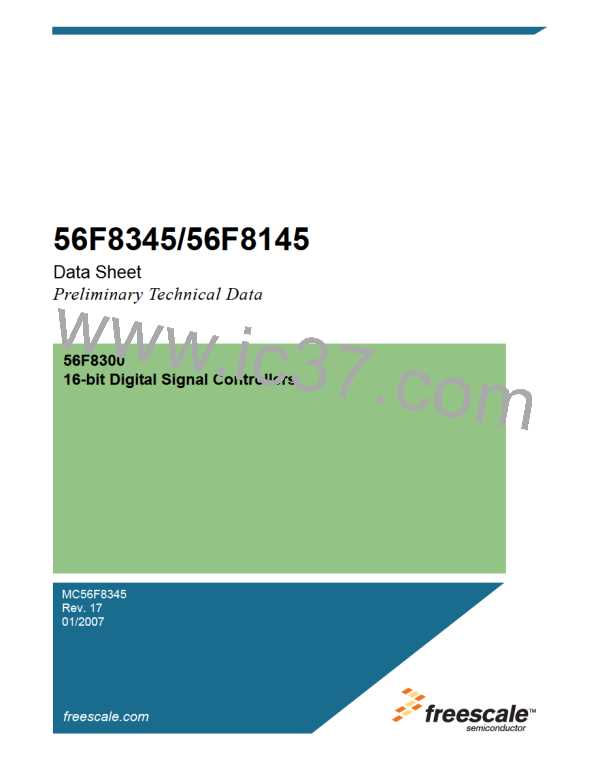Signal Pins
Table 2-2 Signal and Package Information for the 128-Pin LQFP
State
During
Reset
Signal
Name
Pin No.
Type
Signal Description
PHASEA1
9
Schmitt
Input
Input,
pull-up
enabled
Phase A1 — Quadrature Decoder 1, PHASEA input for decoder
1.
(TB0)
Schmitt
Input/
TB0 — Timer B, Channel 0
Output
(SCLK1)
Schmitt
Input/
Output
SPI 1 Serial Clock — In the master mode, this pin serves as an
output, clocking slaved listeners. In slave mode, this pin serves
as the data clock input. To activate the SPI function, set the
PHSA_ALT bit in the SIM_GPS register. For details, see Part
6.5.8.
(GPIOC0)
Schmitt
Input/
Port C GPIO — This GPIO pin can be individually programmed
as an input or output pin.
Output
In the 56F8345, the default state after reset is PHASEA1.
In the 56F8145, the default state is not one of the functions
offered and must be reconfigured.
To deactivate the internal pull-up resistor, clear bit 0 in the
GPIOC_PUR register.
PHASEB1
10
Schmitt
Input
Input,
pull-up
enabled
Phase B1 — Quadrature Decoder 1, PHASEB input for decoder
1.
(TB1)
Schmitt
Input/
TB1 — Timer B, Channel 1
Output
(MOSI1)
Schmitt
Input/
Output
SPI 1 Master Out/Slave In — This serial data pin is an output
from a master device and an input to a slave device. The master
device places data on the MOSI line a half-cycle before the clock
edge the slave device uses to latch the data. To activate the SPI
function, set the PHSB_ALT bit in the SIM_GPS register. For
details, see Part 6.5.8.
(GPIOC1)
Schmitt
Input/
Port C GPIO — This GPIO pin can be individually programmed
as an input or output pin.
Output
In the 56F8345, the default state after reset is PHASEB1.
In the 56F8145, the default state is not one of the functions
offered and must be reconfigured.
To deactivate the internal pull-up resistor, clear bit 1 in the
GPIOC_PUR register.
56F8345 Technical Data, Rev. 17
Freescale Semiconductor
Preliminary
29

 FREESCALE [ Freescale ]
FREESCALE [ Freescale ]